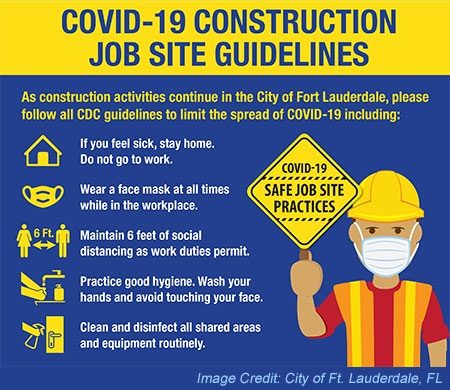Covid-19 Pandemic Drives Significant Changes at Many Construction Sites Across The U.S.
Although Covid-19 has affected various parts of the country with different levels of severity, it's now critically important to have a Covid-19 action plan at many construction sites—at least until the pandemic subsides or a vaccine is developed. In addition to protecting on-site personnel, helping to stem the spread of the virus, and complying with local, state, and federal directives, it's necessary to have an appropriate Covid-19 policy and action plan for financial and liability reasons. Preventing an outbreak on the job site not only helps to keep workers safe, but can help prevent a construction project from being shutdown by local authorities. Beacon's team can help developers, contractors, Surety companies and other stakeholders by reviewing (and/or helping to develop) Covid-19 action / response plans. At a high level, a good Covid-19 policy and action plan consists of all of the following...
Although Covid-19 has affected various parts of the country with different levels of severity, it's now critically important to have a Covid-19 action plan at many construction sites—at least until the pandemic subsides or a vaccine is developed. In addition to protecting on-site personnel, helping to stem the spread of the virus, and complying with local, state, and federal directives, it's necessary to have an appropriate Covid-19 policy and action plan for financial and liability reasons. Preventing an outbreak on the job site not only helps to keep workers safe, but can help prevent a construction project from being shutdown by local authorities. Beacon's team can help developers, contractors, Surety companies and other stakeholders by reviewing (and/or helping to develop) Covid-19 action / response plans.
At a high level, a good Covid-19 policy and action plan consists of all of the following:
- Clear written policy regarding new site procedures designed to reduce the potential that Covid-19 will be spread on a construction site
- A communication / education plan to ensure that all on-site personnel (and site visitors) are aware of the policy
- Designated professional (such as site safety officer) in charge of helping to implement and enforce the plan
- Physical and procedural changes on site to help protect workers and site visitors
Although the plan may vary from region to region, size of project, and which "phase" the region is in, some of the on-site physical and procedural changes which may be necessary include:
- Educating all on-site workers about Covid-19 symptoms and having a clear policy for them to follow if they feel they may have the virus
- Implementing some level of screening (such as temperature checks and/or self reporting) to prevent sick workers (or visitors) from coming on site
- Implementing policies related to physical distancing of workers (and modifying work plans as needed to achieve physical distancing)
- Increased frequency of scheduled cleaning and disinfecting of common work areas, bathrooms, break rooms, and shared tools
- Providing appropriate personal protective equipment (PPE) for workers tasked with cleaning
Having handwash stations (and hand sanitizer) prominently located on the site - Ensuring that all on-site personnel have appropriate PPE (such as face masks, N95 masks, gloves, and protective eyewear) as required by local and/or national guidelines, particularly in cases where social distancing may not be possible for specific job-site tasks
- Limiting access to the site by non-essential personnel
- Increased use of remote communication / web video conferencing for meetings with project staff and partners who don't need to be physically present on site
- Having a clear response plan to follow when an employee shows symptoms and/or tests positive for Covid-19
- Regularly scheduling site safety meetings and training to ensure that all on-site personnel are aware of the Covid-19 action plan and their own responsibilities
- Replacing job site sign-in using shared pen with roll call or other "touch-free" method to track attendance
- Identifying solutions to avoid employees being in close proximity (such as the use of one-way staircases, signage and direction markings to reduce congestion in specific "pinchpoint" areas on the site
- Having appropriate signage on site to remind workers about Covid-19 policies on site
- Where possible, install temporary “foot-pulls" on job-site doors to reduce touchpoints
- Periodically reviewing and updating the Covid-19 plan as conditions change
Please Contact Beacon if you have need help related your site's Covid-19 Policies & Action Plan.
